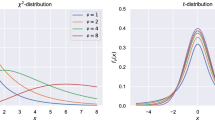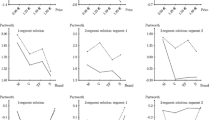Abstract
Multinomial choice models are used for the analysis of unordered, mutually exclusive choice alternatives. Conventionally used multinomial choice models are the multinomial logit, nested logit, multinomial probit and random parameters logit models. This paper develops multinomial choice models based on Archimedean copulas. In contrast to the multinomial logit and nested logit models, no independence of irrelevant alternatives property is implied. Moreover, copula-based multinomial choice models are more parsimonious than the multinomial probit and random parameters logit models, which makes them attractive from a computational point of view and makes them particularly suitable for prediction purposes. When the number of alternatives becomes large, additional complexity can be introduced using nested Archimedean copulas. Nested structures can often be motivated from individual behavior. The paper also considers an empirical application to travel mode choice. It is found that copula-based multinomial choice models provide a good compromise between fit and parsimony.



Similar content being viewed by others
References
Andrews, D.W.K.: Testing when a parameter is on a boundary of the maintained hypothesis. Econometrica 69, 683–734 (2001)
Genius, M., Strazzera, E.: Applying the copula approach to sample selection modelling. Appl. Econ. 40, 1443–1455 (2008)
Greene, W.H.: Econometric analysis, 7th edn. Pearson Prentice Hall, Upper Saddle River (2012)
Heckman, J.J.: Sample selection bias as a specification error. Econometrica 47, 153–161 (1979)
Hofert, M.: Construction and sampling of nested Archimedean copulas. In: Jaworski, P., Durante, F., Härdle, W.K., Rychlik, T. (eds.) Copula theory and its applications, Lecture Notes in Statistics, vol. 198, pp. 147–160. Springer, Heidelberg (2010)
Hofert, M.: Efficiently sampling nested Archimedean copulas. Comput. Stat. Data Anal. 55, 57–70 (2011)
Hofert, M.: A stochastic representation and sampling algorithm for nested Archimedean copulas. J. Stat. Comput. Simul. 82, 1239–1255 (2012)
Hofert, M., Mächler, M.: Nested Archimedean copulas meet R: the nacopula package. J. Stat. Softw. 39, 1–20 (2011)
Joe, H.: Multivariate models and dependence concepts. Chapman and Hall, London (1997)
Lee, L.F.: Generalized econometric models with selectivity. Econometrica 51, 507–512 (1983)
McFadden, D.: Conditional logit analysis of qualitative choice behavior. In: Zarembka, P. (ed.) Frontiers in econometrics, pp. 105–142. Academic Press, New York (1974)
Nelsen, R.B.: An introduction to copulas. Springer, New York (2006)
Okhrin, O., Okhrin, Y., Schmid, W.: On the structure and estimation of hierarchical Archimedean copulas. J. Econom. 173, 189–204 (2013)
Patton, A.J.: A review of copula models for economic time series. J. Multivar. Anal. 110, 4–18 (2012)
Prieger, J.E.: A flexible parametric selection model for non-normal data with application to health care usage. J. Appl. Econom. 17, 367–392 (2002)
Smith, M.D.: Modelling sample selection using Archimedean copulas. Econom. J. 6, 99–123 (2003)
Smith, M.D.: Using copulas to model switching regimes with an application to child labour. Econ. Rec. 81, S47–S57 (2005)
Train, K.: Discrete choice methods with simulation. Cambridge University Press, Cambridge (2009)
Trivedi, P.K., Zimmer, D.M.: Copula modeling: an introduction for practitioners. Found.Trends Econom. 1, 1–111 (2007)
Vuong, Q.H.: Likelihood ratio tests for model selection and non-nested hypotheses. Econometrica 57, 307–333 (1989)
Winkelmann, R.: Copula bivariate probit models: with an application to medical expenditures. Health Econ. 21, 1444–1455 (2012)
Zimmer, D.M., Trivedi, P.K.: Using trivariate copulas to model sample selection and treatment effects: application to family health care demand. J. Bus. Econ. Stat. 24, 63–76 (2006)
Author information
Authors and Affiliations
Corresponding author
Rights and permissions
About this article
Cite this article
Schwiebert, J. Multinomial choice models based on Archimedean copulas. AStA Adv Stat Anal 100, 333–354 (2016). https://doi.org/10.1007/s10182-015-0262-8
Received:
Accepted:
Published:
Issue Date:
DOI: https://doi.org/10.1007/s10182-015-0262-8




